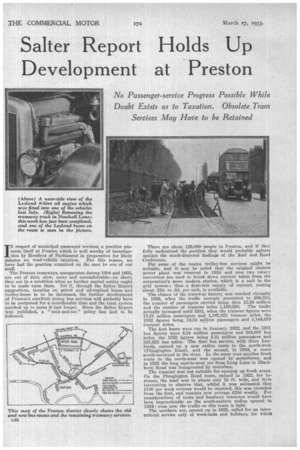Salter Report Holds Up Development at Preston
Page 96

Page 97

If you've noticed an error in this article please click here to report it so we can fix it.
IN respect of municipal passenger services, a position presents itself at Preston which is well worthy of investigation by Members of Parliament in preparation for likely debates on road-vehicle taxation. For this reason, we have had the -position examined on the spot by one of our staff.
The Preston tramways, inaugurate(' during 1904 and 1905, are out of date, slow, noisy and uncomfortable—in short, they are in a condition when no further capital outlay ought to be made upon thern. Yet if, through the Salter Report suggestions, taxation on petrol and oil-engined buses and trolley-buses is to be increased, the further development of Preston's excellent young bus services will probably have to be postponed for a considerable time and the train system patched up to make it last longer. Since the Salter Report was published, a " wait-and-see " policy has had to be followed. There are about 126,000 people in Preston, and if they fully understood the position they would probably agitate against the much-disputed findings of the Rail and Read Conference.
For some of the routes trolley-bus services might he suitable, and it may be noted that the original electric power plant was removed in 1924 and now two rotary converters are used to break down current taken from the corporation's more modern station, which is a unit in the grid system ; thus a first-rate supply of current, costing about .75d. to .8d. per unit, is available.
The climax of the tramway history was reached virtually in 1922, when the traffic receipts amounted to £99,318, the number of passengers carried being then 10.26 million and the number of tramcar miles 1,190,220. The traffic actually increased until 1981, when the tramcar figures were 15.21 million passengers and 1,167,823 tramcar miles, the 1932 figures being 14.34 million passengers and 1,144,879 tramcar miles.
The first buses were run in January, 1922, and the 1931 bus figures were 4.24 million passengers and 882,087 bus miles, tlui 1932 figures being 4.21 million passengers and 381,853 bus miles. The first bus service, with three Leylands, opened up a new radius route to the north-west (Phingington Road), and the second, in 1924, a route south-eastward to the river. In the same year another fresh route to the north-west was opened by motorbuses, and in 1925 the long east-to-west arc from Long Lane to Blackburn Road was inaugurated by motorbus.
The tramcar was not suitable for opening up fresh areas. On the Plungington Road route, opened in 1922, for instance, the road was in places only 18 ft. wide, and itiis interesting to observe that, whilst it was estimated that £100 per week revenue would be required, this was exceeded from the first, and 'receipts now average ..250 weekly. For considerations of route and headway tramcars would have been impracticable on the south-eastern radius opened in 1924; even now the traffic on this route is light. The northern arc, opened up in 1925, called for an intermittent service only at week-ends and holidays, for which tramcars were unsuitable, and a modification of this route (via St. Thomas's Road) was started in 1932 to operate during only morning, noon and evening rush hours, for which, again, the tramcar would not be suitable.
In July last year the route along Ribbleton Lane was made to operate as a co-ordinated bus and tram service of five to ten minutes' headway.
The situation really became interesting in 1932, when certain sections of the rail required renewal. The corporation had, in its 1931 Act, obtained trolley-bus powers, and the intention when introducing the Bill (in 1930) was to substitute trolley-buses instead of renewing track. Just at that time, however, the oil engine commenced to demand attention, and the council thought it unwise tobecome committed for 15 to 20 years in respect of trolley-bus outlay.
Thus in 1932 conversion to motorbus operation on the Farringdon Park-Penwortham and partial conversion on the Ribbleton Road routes were effected, these calling for 10 new Leyland double-deckers and four Leyland singledeckers, the bodies for all of which were made at the English Electric Works, Preston.
There still remain the two radius routes and one circular route operated by tramcars, as well as the alternate tram and bus service on Ribbleton Road.
On the latter route the single-track portion was renewed in 1929, the cost of about £4,000 being less than would have been the cost of half a dozen further buses, and the attitude towards trolley-buses having at that time not been determined. The track on the remainder of that route had been renewed between 1919 and 1927, so that the rail is good for several years. The tramcars, however, may not last out the track, As the position is at present, if heavier taxation on trolley-buses and motorbuses be introduced, a policy of extending the life of the tram system, to the obvious inconvenience of the whole population, may be inevitable.
The corporation is obtaining firsthand experience of the oil engine, having fitted one of the Leyland 8-litre units into a double-decker in July, 1932. This engine is running well, and has covered over 20,000 miles without passengers realizing that the bus was different from any of the other vehicles, and the saving on fuel is 2.25d. per mile, whilst it does not seem that this will be balanced by heavier maintenance charges.




































































































































































